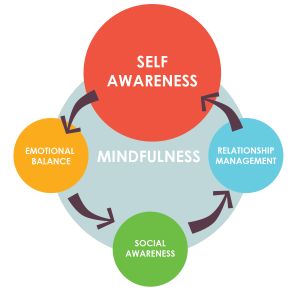While walking along the shores of Lake Erie last weekend, my friend Jim shared an unusual conversation he overheard that morning. It involved a guy talking to his dog: reassuring him about getting water, informing him about the day’s agenda, and venting some personal frustrations.
involved a guy talking to his dog: reassuring him about getting water, informing him about the day’s agenda, and venting some personal frustrations.
I laughed. It sounded funny. But then I remembered how I use to talk to my dog.
Mostly I praised him, occasionally I vented frustrations, I always let him know when I would be away, and sometimes, I’d rehearse an upcoming presentation with him as we walked around the block; I find talking out loud a helpful practice for mastering public speaking.
Talking to your dog, or other pets, can be helpful. But if that isn’t how you like to decompress, vent, share information, or gain perspective, there are other options. And many of them help us to be more mindful.
What is Mindfulness?
The quality or state of being aware. Mindfulness is an important step for strengthening communication skills, building strong relationships, and creating productive healthy work environments.  
It begins with Self-Awareness: the ability to perceive emotions accurately, and to recognize when you feel out of sorts, what triggers feelings, and how emotions can alter behavior.
We all get stressed, but different experiences stress different people, and our responses to stress vary. While some thrive on last minute plans and changes, others find that stressful. And while some people retreat when they’re stressed, others become motivated or even confrontational.
Then there’s Social Awareness: understanding and responding to the emotions, concerns, and needs of others. Understanding others (Empathy) – means putting yourself in someone else’s shoes: How would I feel if that were me?
Responding to others’ emotions and behavior especially when it’s challenging is Relationship Management. For example: when someone is unfair or unreasonable, what do you do? It’s about communication that builds bonds and strengthens collaborations.
It’s challenging
It’s no secret that good communication and strong relationships contribute to successful, productive work environments. But applying this knowledge can be challenging.
Solutions
Mindfulness requires attention, curiosity, and practice.
- Start by noticing your feelings in different situations, times of day, with different people and how they affect your attitude, feelings, performance, or behavior
- Ask questions before you respond
To yourself: How’s my mental, emotional, or physical state: am I ready, grounded, have an agenda, how’s my attitude? Do I need to… pause, vent, clarify my words?
About others: Before assuming, another’s intentions or character, ask what else could
be true about why they are… not responding, grumpy, missing work.
- Identify tools/ practices that can help you pause, decompress, vent, gain perspective: Meditation, venting to a trusted ally, being in nature, exercise, sleep, listening to music, writing/journaling, walking/talking to your dog.
Mindfulness can help us respond more deliberately, soften our reactions, and prevent us from being pulled into situations we can’t yet handle. The goal? To help us respond from the wisest, most centered part of ourselves.
So, while it might look silly to talk to a dog in public, or appear weak to pause before responding to a difficult person or situation, taking time out to have a well- thought- out response could be the best thing you do. It’s one action we can all take to make the workplace and world a little better.
